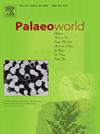New eurypterids from the Lower Devonian Nagaoling Formation of Guangxi, South China
IF 1.7
3区 地球科学
Q2 PALEONTOLOGY
引用次数: 0
Abstract
Eurypterids, commonly known as sea scorpions, were an extinct group of arthropods renowned for their large size and role as apex predators in Early Paleozoic marine ecosystems. Among them, carcinosomatids and pterygotids stand out as two particularly striking groups, both characterized by their large size but differing in morphological specialization. Compared to their diversity and abundance in Laurussia, both groups are rare in the larger Pan-Gondwanan region, which is consistent with the general pattern observed from most eurypterids, especially the Devonian genera. Here, we report a new diverse eurypterid fauna from the Nagaoling Formation (Lochkovian, Devonian) in Guangxi, South China, including Carcinosomatidae, Pterygotidae, and Adelophthalmidae. Tigrisopterus zengi n. gen. n. sp. represents the youngest known carcinosomatid worldwide and the first Devonian member of this family discovered outside Laurussia. Acutiramus sp., with an estimated body length of approximately 1.6–1.8 m, is the first Acutiramus component found in China and one of the youngest representatives of this genus known to date. These two families, along with the generalist Adelophthalmus found in the same bed, suggest a complex ecological structure in the Devonian shallow marine environment of South China. This discovery expands both the temporal and spatial distribution of carcinosomatids and pterygotids, providing new insights into the distribution and evolutionary history of these ancient predators.
广西下泥盆统那高岭组新泛龙类
广翅类,俗称海蝎子,是一种已灭绝的节肢动物,以其庞大的体型和在古生代早期海洋生态系统中作为顶级捕食者的角色而闻名。其中,癌体虫和翼虫是两个特别引人注目的类群,它们的特点都是体型大,但形态专门化不同。与Laurussia的多样性和丰度相比,这两个类群在更大的Pan-Gondwanan地区是罕见的,这与大多数泛蝶类,特别是泥盆纪属的一般模式一致。本文报道了广西泥盆纪那高岭组(Lochkovian, Devonian)的一种新的泛翅类动物群,包括癌虫科、翼虫科和Adelophthalmidae。Tigrisopterus zengi n. gen. n. sp.代表了世界上已知最年轻的癌体虫,也是该家族在俄罗斯以外发现的第一个泥盆纪成员。acutramus sp.体长约1.6 ~ 1.8 m,是中国发现的第一个acutramus成分,也是该属已知最年轻的代表之一。这两个科,连同在同一层位发现的多面体Adelophthalmus,表明中国南方泥盆纪浅海环境中存在一个复杂的生态结构。这一发现扩大了癌体虫和翼足虫的时空分布,为这些古代食肉动物的分布和进化历史提供了新的见解。
本文章由计算机程序翻译,如有差异,请以英文原文为准。
求助全文
约1分钟内获得全文
求助全文
来源期刊

Palaeoworld
PALEONTOLOGY-
CiteScore
4.00
自引率
5.90%
发文量
95
期刊介绍:
Palaeoworld is a peer-reviewed quarterly journal dedicated to the study of past life and its environment. We encourage submission of original manuscripts on all aspects of palaeontology and stratigraphy, comparisons of regional and global data in time and space, and results generated by interdisciplinary investigations in related fields. Some issues will be devoted entirely to a special theme whereas others will be composed of contributed articles. Palaeoworld is dedicated to serving a broad spectrum of geoscientists and palaeobiologists as well as serving as a resource for students in fields as diverse as palaeobiology, evolutionary biology, taxonomy and phylogeny, geobiology, historical geology, and palaeoenvironment.
Palaeoworld publishes original articles in the following areas:
•Phylogeny and taxonomic studies of all fossil groups
•Biostratigraphy, chemostratigraphy, chronostratigraphy
•Palaeoecology, palaeoenvironment and global changes throughout Earth history
•Tempo and mode of biological evolution
•Biological events in Earth history (e.g., extinctions, radiations)
•Ecosystem evolution
•Geobiology and molecular palaeobiology
•Palaeontological and stratigraphic methods
•Interdisciplinary studies focusing on fossils and strata
 求助内容:
求助内容: 应助结果提醒方式:
应助结果提醒方式:


